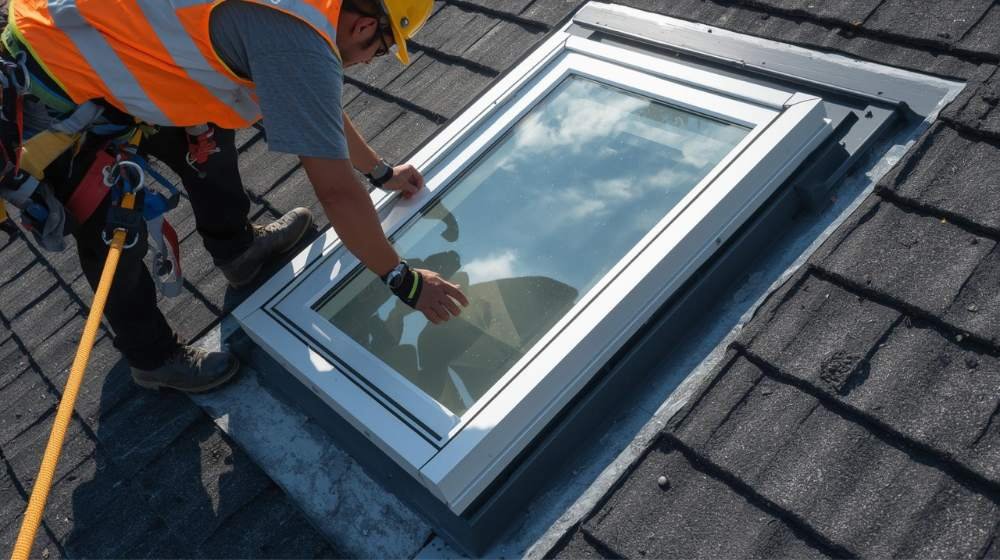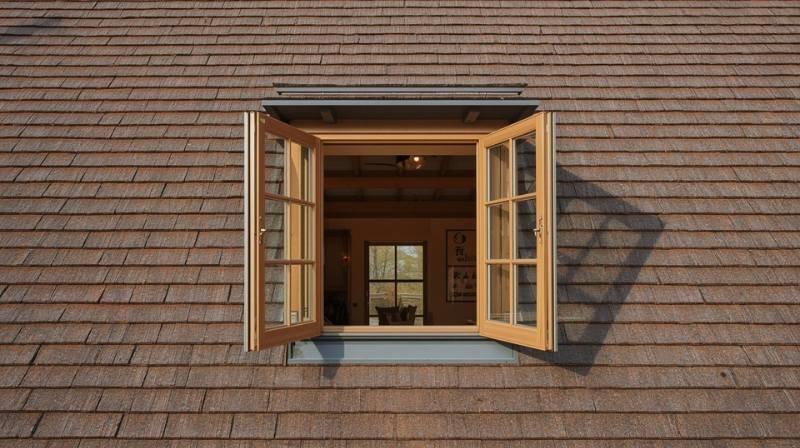
Have you ever wondered if a skylight or a roof window would be preferable for you when you look up at your Brooklyn roof?
If you live in a brownstone or a rowhouse, the choice is not just about style. It shapes daylight, airflow, comfort, and even resale. In this guide on Skylight vs. Roof Window: Which Is Better for Brooklyn Home, we’ll keep it simple and clear while pointing to the details that matter. We’ll explore how roof pitch determines the winner, the importance of curb height on flat roofs, and the meaning behind U-factor, SHGC, and low-E.
Stay with me for a few minutes, and you’ll know when a curb-mounted skylight brings life to the center of your home and when an operable roof window turns an upper floor into a cooler, brighter retreat.
What is Skylight?
A skylight is a window set into the roof that brings daylight from above. It can be fixed for light only or vented to allow fresh air. On flat roofs, it usually sits on a raised curb that ties into the waterproof membrane. Quality low-E glass helps manage heat, glare, and UV.
What is a window roof?
A roof window is a window set into a sloped roof that delivers daylight and real ventilation. It opens like a regular window, so you can control airflow and clean the glass from inside. It has simple functionality along with clear visibility due to its reachable position. A roof window works well for roof conversions and steep-pitch roofs, according to the Brooklyn Homes Skylight vs. Roof Window decision.
When to Use Skylight Windows
If your house has no wall windows in a room’s interior, consider installing a skylight. In Brooklyn, curb-mounted skylights that connect to the membrane are preferred on flat roofs. Stairwells, kitchens, and bathrooms get natural light without sacrificing privacy. You can control summer heat, lower the sunlight, and block most UV rays by using low-E glass.
When to Use Roof Windows
Choose roof windows if you want light and a crosswind in a room on the top floor. They look wonderful in bedrooms and offices, especially on rooftops that become too hot in the summer. For appropriate flashing and drainage, a pitched roof with the right level of slope is needed. An adjustable roof window in Brooklyn’s weather cools down faster after a hot day. It gives you a view that makes your home more valuable.
10 Key Differences between Skylights and Roof Windows
Skylights focus on overhead light and simple weather protection, while roof windows add everyday use with views and easy airflow. Roof pitch, access, cleaning, installation, energy control, and code rules set them apart. In short, skylights suit interior light needs, and roof windows suit livable top-floor rooms.
Roof Type Compatibility
Skylights work on flat roofs with a curb and on low to medium slopes. Roof windows need a steeper pitch for drainage and safe operation. In brownstones with flat roofs, curb-mounted skylights fit more often. In pitched rowhouse additions, roof windows fit the geometry and perform well.
Skylight vs Roof Window: Operation & Ventilation
A skylight acts like a daylight pro, while a roof window works like a whole window up in the roof. Both move air and lift comfort, but they do it in different ways. Choose what matches your space usage and roof construction.

Skylights: Operation & Ventilation
- Fixed units stay closed; they flood rooms with steady, soft light.
- Vented skylights open by crank, wall switch, or remote; you get quick air changes on demand.
- Short ventilation circulates air gently, which makes bathrooms and kitchens seem fresher quickly.
- Many models include rain sensors that auto-close at the first drops.
- Optional shades and insect screens control breeze, glare, and privacy.
Roof Windows: Operation & Ventilation
- The sashes can turn or swing open, and the heat and steam leave quickly.
- Top-hung or center-pivot designs give precise control over opening angles.
- Add a lower window for a cross-breeze that sweeps the whole room.
- Night purge is effective on hot days because warm air rises to the roofline.
- Trickle vents maintain a slow, steady exchange when the sash remains closed.
Skylight vs Roof Window: Cleaning & Maintenance
Both can last for decades with basic care. The big difference lies in access. A roof window invites inside cleaning, while many skylights call for safe roof access. A simple checklist keeps each one in top form.
Skylights: Cleaning & Maintenance
- Exterior glass often needs roof access or a secure platform.
- Keep leaves and grit out of flashing paths; water moves off the roof without detours.
- Inspect curb seals, fasteners, and gaskets each season for tight joints.
- Test motors, remotes, and rain sensors twice a year; replace batteries on schedule.
- Dust interior shades and look for moisture marks that hint at condensation.
Roof Windows: Cleaning & Maintenance
- Rotate the sash and clean the outside pane from inside the room.
- Clear weep channels so condensation drains the right way.
- Lubricate hinges and locks each season for smooth action.
- Check perimeter seals for a snug, draft-free close.
- Watch drywall and trim around the opening after big storms; fix hairline cracks early.
Differences in Installation Process
Installation differs at the curb, the frame, and the interior finish, so plan the opening and flashing before you cut.
| Aspect | Skylight | Roof Window |
| Roof slope need | Works on flat roofs with a curb and on low slopes | Needs a steeper pitch for drainage and warranty |
| Framing change | Often fits between rafters with minimal cuts | Often needs a framed rough opening with structural headers |
| Weatherproofing | Curb or deck-mounted unit with step or continuous flashing | Factory flashing kit that matches roof pitch and material |
| Interior finish | Light shaft or tunnel to the ceiling below | Shorter shaft or none, since the sash sits within reach |
| Labor scope | Faster install on simple roofs and small sizes | Longer install with drywall, trim, and sash adjustments |
Differences of Daylight & Views
A skylight sends daylight deep into the plan and brightens the center of the home. It gives a slice of sky and a soft, diffuse glow. A roof window delivers direct views of rooftops and trees and adds a stronger sense of connection to the outdoors. It also shapes contrast and gives more control over glare with shades and tilt control.
Skylight vs Roof Window: Interior Build-Out
Skylights often require a light shaft to funnel daylight through the ceiling. The shaft can be straight or flared to spread light wider. Roof windows sit within reach on a sloped ceiling, so trim and drywall work stay minimal. You also get usable wall space under the window for a desk or a reading nook.

Energy & Comfort Controls: Skylight vs Roof Window
Low-E glass with a tight U-factor keeps winter heat inside. A balanced SHGC cuts summer glare and heat gain. Skylights work best with interior shades or exterior light screens when rooms face harsh sun. Roof windows add night flush ventilation that drops temps fast and feels natural.
Cost Comparison Between Skylight and Roof Window for Brooklyn, NYC
| Item | Skylight (per unit) | Roof Window (per unit) |
| Material cost | $500–$2,000 for most glass skylights (unit only) | $480–$1,800 for window + $80–$250 flashing kit |
| Repair cost | $2,000–$5,300 typical for replacements (scope drives price) | $350–$900 typical hardware/seal tweaks; full sash replacement costs more |
| Labor cost | $1,200–$3,200 typical install labor in NYC-type markets | $1,200–$2,800 in Brooklyn for new openings and finish work (plan for upper end) |
| Installation cost (total) | $2,500–$6,000 installed in NYC for most fixed/vented models; solar often lands near the top | $2,800–$5,000 installed is a practical Brooklyn budget band |
Durability and Lifespan
Both hold up well when flashing, glazing, and installation details stay correct. With quality parts and proper installation, 20 to 30 years is common. Fixed skylights have fewer moving parts, so they often last longer with less maintenance. Roof windows use heavy-duty hinges and seals that run for years with light care, but they need periodic checks. If you want the toughest option with the least maintenance, a fixed skylight usually wins.

Skylight vs Roof Window: Code & Historic Context
Both products must meet building codes for safety glass, wind loads, and roof drainage. In NYC, you usually need a permit to make fresh ventilation or changes to the building. In landmarked Brooklyn districts, the Landmarks Preservation Commission may ask for low-profile units that do not show from the street. Skylights usually pass more easily on flat roofs out of sight. In contrast, roof windows can face extra review if visible from the sidewalk.
Quick Comparison Between Skylight and Roof Window
Both options bring natural light, but they serve different goals. Use this side-by-side to match the product to your roof, your room, and your comfort needs.
| Factor | Skylight | Roof Window |
| Roof type fit | Works well on flat roofs with a curb and on low slopes | Works best on pitched roofs with adequate slope |
| Daylight & views | Strong overhead light and a slice of sky | Bright light plus direct views and a more open feel |
| Ventilation control | Fixed or vented units; light first, airflow second | Wide opening sash; light and strong airflow in one |
| Cleaning & access | Often needs roof access for exterior glass | Pivots or swings for easy inside cleaning |
| Cost & install | Lower to moderate total on simple roofs | Higher total with more interior trim and framing |
Which Is Better for Brooklyn’s Weather: Skylight vs Roof Window?
Brooklyn experiences humid summers, cold winters, and stormy periods, making the “best” choice depend on your roof and room. Curb-mounted skylights with low-E laminated glass and suitable curb height handle storms and brighten flat roofs and inner rooms. Roof windows release heat quickly on warm nights and insulate efficiently in winter on pitched roofs and living rooftops. If you want a simple rule, pick a skylight for flat-roof interiors and choose a roof window for pitched-roof living spaces.
Why should you choose a professional roofing contractor?
Are you looking for an expert roofing contractor in Brooklyn, NYC? SR General Construction has you covered! Our business is located at 8807 Avenue B, Brooklyn, NY 11236, United States, in the Canarsie area.
We proudly serve all areas of Brooklyn with high-quality, durable roofing solutions. From new installations to repairs and maintenance, we provide the best service at affordable prices. Contact us and experience why we’re Brooklyn’s roofing experts!
FAQ
1. Are skylights and roof windows the same?
No. A skylight primarily delivers overhead daylight, while a roof window opens and provides controllable ventilation and outward views.
2. Can I install a skylight on a flat roof in Brooklyn?
Yes, use a curb-mounted skylight. NYC code requires unit skylights on low-slope roofs to sit at least 4 inches above the roof plane on a curb unless specific pitched exceptions apply.
3. What roof pitch do roof windows need?
Most roof windows accept installation from 15° to 90°, depending on the model and hardware. Verify the pitch range in the product data and match the correct flashing kit.
4. Which gives stronger natural ventilation: a skylight or roof window?
A roof window. The sash opens wide and sits within reach, so hot air purges quickly; vented skylights improve air change but usually move less air per opening.
5. Which is easier to clean from the inside?
Roof windows. Many center-pivot designs rotate to a 180° cleaning position and lock for safe interior cleaning of the outer pane.
6. What U-factor and SHGC should I target?
Choose the lowest practical U-factor for winter comfort, then tune SHGC to limit summer gain. Use products meeting the latest ENERGY STAR Version 7.0 criteria as your baseline.
7. What does “curb-mounted” mean on a flat roof?
The unit sits on a raised curb integrated with the waterproofing; the skylight frame then mounts to that curb. NYC code spells out the minimum 4-inch curb height for low-slope conditions.
